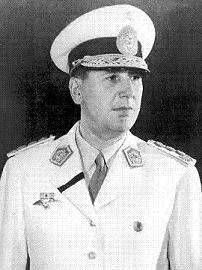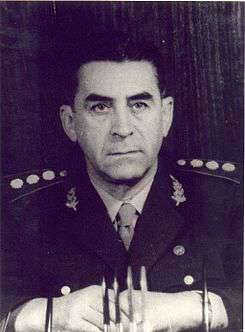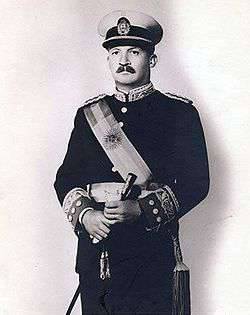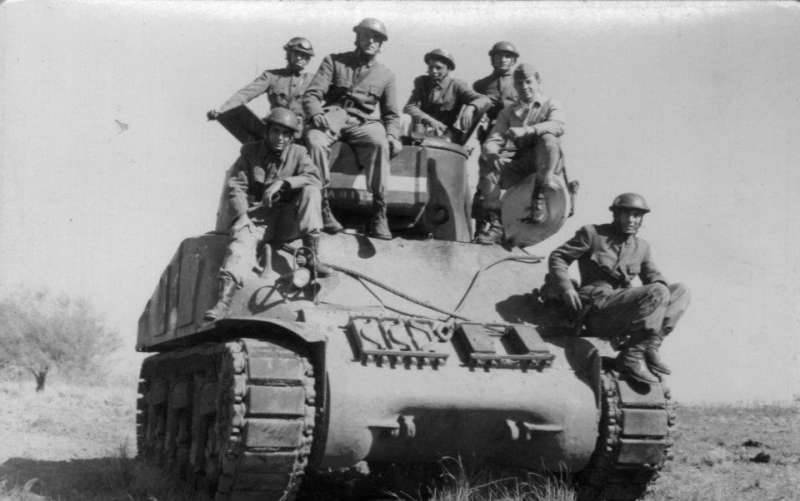"Red" against "blue". Rise of the fleet against the army and aviation
 History Argentina in the twentieth century marked by an endless series of military coups. Perhaps the most famous worldwide military leader of Argentina for the entire twentieth century was Juan Domingo Peron (1895-1974). The views of Peron, who served as military attaché in Italy, were influenced by Italian fascism. In November, 1943, Colonel Peron, led the Argentine Ministry of Labor and Social Development. In this post, Peron encouraged the trade union movement, which earned the support of a large part of Argentine workers. In 1944, he became vice-president of the country, and from 1946 to 1955. served as president. Peron’s world view and regime are called Peronism, although he himself preferred the term “industrialist”. For Peronism, belonging to the ideologies of the “third way”, were characterized by an authoritarian style of government, economic self-sufficiency of the state, an orientation towards social justice and public support, nationalization of the central bank and large-scale industry. Peron’s activity caused dissatisfaction with right-wing conservative and pro-American circles in the Argentine political and military elite. In 1955, the Peron regime was overthrown as a result of a military coup led by Lt. Gen. Eduardo Lonardi, a former military attaché in Washington.
History Argentina in the twentieth century marked by an endless series of military coups. Perhaps the most famous worldwide military leader of Argentina for the entire twentieth century was Juan Domingo Peron (1895-1974). The views of Peron, who served as military attaché in Italy, were influenced by Italian fascism. In November, 1943, Colonel Peron, led the Argentine Ministry of Labor and Social Development. In this post, Peron encouraged the trade union movement, which earned the support of a large part of Argentine workers. In 1944, he became vice-president of the country, and from 1946 to 1955. served as president. Peron’s world view and regime are called Peronism, although he himself preferred the term “industrialist”. For Peronism, belonging to the ideologies of the “third way”, were characterized by an authoritarian style of government, economic self-sufficiency of the state, an orientation towards social justice and public support, nationalization of the central bank and large-scale industry. Peron’s activity caused dissatisfaction with right-wing conservative and pro-American circles in the Argentine political and military elite. In 1955, the Peron regime was overthrown as a result of a military coup led by Lt. Gen. Eduardo Lonardi, a former military attaché in Washington. "Red" and "Blue"
Since that time, the Argentine military elite, which traditionally played a crucial role in the political life of the country, began a poorly concealed confrontation between the two main groups. The first was called "Asules" - "Blue", and united supporters of liberal-democratic views. She was fully supported by the generals and officers of the Argentine Air Force, as well as most of the generals and officers of the Ground Forces. The actual leader of “Asules” was Lieutenant-General Juan Carlos Ongania (1914-1995), Chief of Staff of the Ground Forces.
The second group was called “Colorados” - “Reds,” and included supporters of right-wing conservative views, advocating an uncompromising stance on Peronism and Peronist political organizations (the right, as you know, hated Peron for his anti-clerical views and support for the trade union movement). Colorado’s enjoyed the most support in the Navy, including the Marines and the Marines. Aviation. In addition, they were supported by a smaller part of the officer corps of the Ground Forces. The leader of the Colorado was Brigadier General Pascual Angel Pistarini (1915-1999), after graduating from the National Military College in 1936, served in the cavalry and commanded one of the cavalry divisions.
 Colorado support on navy It was explained by the fact that service in the Navy was considered very prestigious in Argentina and many representatives of rich and influential families went there. In the ground forces, on the contrary, were representatives of the middle and even lower strata of society. Air Force officers, by virtue of education and origin, also differed in more leftist and liberal views.
Colorado support on navy It was explained by the fact that service in the Navy was considered very prestigious in Argentina and many representatives of rich and influential families went there. In the ground forces, on the contrary, were representatives of the middle and even lower strata of society. Air Force officers, by virtue of education and origin, also differed in more leftist and liberal views. The first confrontation between Colorados and Asules took place as early as September 1962. In Buenos Aires, an armed confrontation continued between the opposing factions of the military for a week. Since aviation was in the hands of Asules, they quickly won an advantage in the air and attacked Colorados positions in the neighborhoods of Buenos Aires. When the victory of “Asules” became apparent, the leaders of the Colorados hurried to start negotiations, after which an agreement was reached between the parties to the conflict. In fact, power was in the hands of General Juan Ongania, who led Asules and set out to gradually oust the Colorados from key positions in the army and government. These actions Ongania caused sharp discontent on the part of generals and admirals belonging to the group of "Red". Already at the beginning of 1963, dissatisfied with the policy of Ongania, senior officers of the army, aviation and navy decided to organize a conspiracy to prevent the elections scheduled for July 7, 1963. The conspirators included the former vice-president Isaac Rojas, generals Benhamin Menendez, Federico Montero, Admirals Arturo Rial, Carlos Sánchez Sanudo, Commodore Aviation Osvaldo Lentino. The speech of the loyal conspirators was assigned to 2 on April 1963. It is noteworthy that the Argentine military intelligence received information about the plot to be prepared and even determined the composition of the conspirators, but the leaders of the Asules did not believe the reality of the insurgency and took the information seriously.
April Revolt 2
Early in the morning of April 2, 1963 in several areas of Argentina made marines and several units of the ground forces. Commanders of the most important naval bases of Puerto Belgrano, Rio Santiago, Punta Indio and Mar del Plata spoke in support of the rebels. After that, the headquarters of the fleet and the naval school of mechanics, as well as the building of Radio Argentina, fell into the hands of the rebels. After the seizure of the radio station, one of the Colorados leaders, General Benhamin Menendez, addressed the citizens of the country by radio. At the same time, the rebels continued to attack the positions of government troops. In Puerto Belgrano, units of the marines under the command of Admiral Jorge Palma blocked units of the 5 Infantry Regiment of the ground forces. In Punta Indio, rebel units were joined by naval aviation units whose aircraft made a series of flights over Buenos Aires to spread campaign leaflets.
However, the situation was again complicated by the lack of serious support for the rebels from the personnel of the Argentine Air Force. “Colorados” had influence only among the officers of the aviation units stationed at the bases of Mar del Plata, Reconquista and in the Buenos Aires “Jorge Newbery” airpark. Moreover, when it came to real confrontation, yesterday's supporters of the Reds from among the Air Force officers hurried to go over to the side of the “Blue”, which were supported by the majority of their colleagues. Aviation support, as in September 1962, was once again of key importance to Asules. So, two bomber "Asules" attacked the radio station captured by the "Colorados", after which the rebels were left without a horn and could no longer broadcast their appeal to the people.
"Blue" go on the offensive
 Meanwhile, in 12.45, General Juan Ongania (in the photo) presented an “ultimatum” to Colorados - to lay down weapon no later than 15.00 or he will begin to take active measures against the rebels. But Colorado’s did not heed the words of the general. Maritime aircraft raided the positions of the 8th armored cavalry regiment in the city of Magdalena and hit the location of its units surrounding the Punta Indio naval base. At the same time, naval aviation used aircraft guns, unguided rockets, high-explosive fragmentation and incendiary bombs. According to naval aviation officers, 10 were destroyed as a result of the raids tanks. However, these "victories" in practice turned out to be bravado. Naval pilots managed to disable only 1 tank and 1 artillery tractor. But the victims of the raids were 9 soldiers of the armored cavalry regiment, another 22 soldiers were injured. In response, anti-aircraft artillery shot down two naval aircraft.
Meanwhile, in 12.45, General Juan Ongania (in the photo) presented an “ultimatum” to Colorados - to lay down weapon no later than 15.00 or he will begin to take active measures against the rebels. But Colorado’s did not heed the words of the general. Maritime aircraft raided the positions of the 8th armored cavalry regiment in the city of Magdalena and hit the location of its units surrounding the Punta Indio naval base. At the same time, naval aviation used aircraft guns, unguided rockets, high-explosive fragmentation and incendiary bombs. According to naval aviation officers, 10 were destroyed as a result of the raids tanks. However, these "victories" in practice turned out to be bravado. Naval pilots managed to disable only 1 tank and 1 artillery tractor. But the victims of the raids were 9 soldiers of the armored cavalry regiment, another 22 soldiers were injured. In response, anti-aircraft artillery shot down two naval aircraft. The position of the rebel Colorados was complicated by the fact that they also had no significant influence among the officer corps of the ground forces. Although Colorados supported part of the army officers, the latter served in remote garrisons and could not quickly come to the aid of the rebels at the head of subordinate units. In contrast to the “Colorados”, the leaders of the “Asules” managed to quickly gather the right forces. The ground forces units in Campo del Mayo pushed back insurgents and freed the buildings of the Argentine Navy headquarters, the Jorge Newbery aeropark and the radio station. After that, the Marine Corps, led by admirals of Colorados, were forced to retreat to Puerto Belgrano.
The rout of the "Reds"
The next day, 3 on April 1963, the government units of the ground forces succeeded in capturing the naval bases in La Plata and Rio Santiago, on which the sailors also chose to retreat to Puerto Belgrano, because they had no chance to defend the bases against the outnumbered and armament of ground forces. At the same time, the faithful "Asules" Air Force units received orders to strike at naval naval aviation airfields in order to minimize airborne threats from the rebels. Initially it was supposed to drop bombs on Punta Indio, but because of bad weather, the bombers did not bomb the naval aviation base in Punta Indio, but bombed the base in La Plata. Then over Punta Indio a number of Air Force planes appeared. Naval aviation aerodrome began to be shot with machine guns, to beat on it with unguided rockets. As a result of strikes, naval aviation lost several aircraft at once. After the strikes on the airfield of naval aviation in Punta Indio, among the leaders of the rebels began to creep into doubt the reality of the victory over "Asules". On nine 45 planes, senior and senior officers who played a key role in the preparation of the armed uprising flew from Punta Indio to neighboring Uruguay.
After active operations of the Air Force to destroy the combat potential of naval aviation, negotiations began between the leaders of the Colorados and Asules. But, although the conditions for the surrender of the rebel forces were already resolved, the leaders of the Asules decided to make several control strikes in order to completely eliminate the desire to continue the armed confrontation with Colorado. On the morning of April 4, the tanks of the 8 armored cavalry regiment loyal to the “Asules” entered the territory of the Punta Indio air base. The soldiers of the regiment, demonstrating their decisive attitude, fired eight machine guns at the airfield, causing damage to them. Capturing the base in Punta Indio finally crushed the resistance of the rebels. 5 April 1963 conflict ended with the signing of an agreement between the warring parties. It is noteworthy that this agreement not only provided for the deprivation of the Colorados of the most combat-ready units, but also worsened the defense capability of Argentina itself. Thus, in accordance with the agreement, the number of marines of the Argentine Navy was reduced to 2500 officers and soldiers. Marine units were dispersed across different bases. Also envisaged a trial of all the officers who participated in the revolt on the side of "Colorados". However, 12 September 1963. Argentine President José Maria Guido pardoned all participants in the insurgency.
Consequences of the rebellion for Argentina
The uprising "Colorados" caused great damage to the potential of the Argentine armed forces. The clashes killed 24 military personnel, including 19 land forces soldiers and 5 marines, 87 military personnel received injuries of varying severity. The naval aviation of Argentina as a result of air raids on its airfields lost 24 aircraft, which for her was an extremely significant loss. The naval infantry of the Navy, as we noted above, was reduced in number and, with the aim of preventing the concentration of large parts on any one base, was dispersed by small subunits across different bases.
The three-day "war of the army, air force and navy" could not prevent the elections scheduled for July 7 from taking place. Neither the supporters of Juan Domingo Perona, nor the Argentine Communists did not participate in the elections due to the ban of their organizations, however, a spectrum of liberal and right-wing conservative parties was represented. Arturo Umberto Ilia (1963-1900), a doctor of the Civil Radical Union, was elected President of Argentina. However, Ilya remained president for only three years. The growth of political contradictions in the country's leadership and the strengthening of the positions of the Peronists again provoked discontent of the military elite with the policy of the country's leadership. As a result of the military coup of 1983 on June 28, power in Argentina was again transferred to the leader of “Asules”, Lieutenant General Juan Carlos Ongania, who was later marked by an extremely tough policy of “immoralism” towards youth and student movements that were gaining strength in the country - bans on wearing mini -skirt, long hair, the abolition of university autonomy.

Information